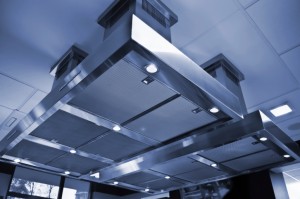
While most hoods are placed on a wall, commercial hood suppression systems can be placed where you need them the most.
When purchasing any new system for your commercial kitchen it
is important to do as much research as possible. But as a new business owner or even just a person who doesn’t know about fire suppression systems, it can be confusing to pick out new systems. Here are some elements of a traditional exhaust system you should look at while shopping for a commercial hood suppression system.
Ventilation Hoods
The largest piece of a commercial hood suppression system is the ventilation hood. But did you know there are actually two different types of hoods? The first hood is a heat exhaust hood that is intended to vent fumes and smoke and equipment that produces high levels of heat. This type of hood is used to vent things that cook at high temperatures like pizza ovens or double-stacked ovens. The second type of hood is a grease exhaust hood. Grease exhaust hoods are used to ventilate exhaust and heat but they feature a slotted hood filter that helps to trap grease, exhaust, and soot. These hoods are intended for use over griddles, deep fryers, and char-broilers. It is important to check with national, state, and local ordinances to ensure your new hood is compliant with the laws in your area.
Exhaust Fans
Every commercial hood system requires a commercial exhaust fan to keep your kitchen properly ventilated. Your fan can either be mounted on the roof of the building or on the wall depending on the building and kitchen layout. Exhaust fans vary in power. Higher powered units are intended to vent larger kitchens or ones with extensive fry stations. You can also choose a model that have an upblast or downblast exhaust in accordance with the local laws. These types of fans help to ensure the exhaust is not directed somewhere it shouldn’t be like at neighboring buildings.
Make-up Air Fans
Since exhaust fans constant draw air out of the kitchen, a make-up fan may be required to improve circulation in the kitchen. These make-up fans are usually placed near the exhaust fan and its primary function is to pump air back into the kitchen. This air is pumped back down into the kitchen to create a steady flow of air that works to channel exhaust into the hoods and to keep the air clean.
Vents, Curbs, and Caps
Every commercial hood systems require some ducts to function correctly. While the hoods funnel exhaust through the vents that lead to the fans, there are also vents that lead back to the kitchen from the fans. Both of these vents for the fan units need a curb, where the vents meet the roof or wall, and a cap, where the fans meet the vents.
Fire Suppression Systems
Fire suppression systems are mandatory in commercial exhaust systems. These systems lead from a tank of fire suppressants to a series of pipes at the end of a sprinkler system resting above the cooking area. These units can be activated both manually and automatically by a heat sensor. Depending on the equipment used in your kitchen, you may require a custom high heat fire suppression system as high heat from different equipment can trigger the heat sensors on average fire suppression system.
There are many different parts of your new commercial hood suppression systems. For more information on purchasing your own from Fireline, call us today!
Commercial Kitchen Fire Protection with Fireline
At Fireline, we offer an array of portable fire extinguishers, fire alarms, and sprinkler systems to keep commercial kitchens safe. Fireline offers the highest quality alarm systems to keep your business safe from fires and carbon monoxide poisoning. We also offer fire suppression systems as well to help keep commercial fires controlled should they break out. Our trained technicians will work with you to determine which air sampling smoke detection system is best for your business. We will also help install and maintain the system for your commercial building.
To get started with Fireline today, or for more information on sprinkler systems call us at 1-800-553-3405, or visit our contact page.
Be sure to “Like” and “Follow” the official Fireline page today on Google+, Facebook, Twitter, and LinkedIn.
